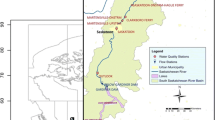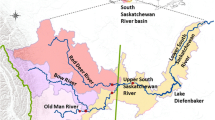Abstract
Physically-based mathematical water quality models are known as potentially effective tools to simulate the temporal and spatial variations of water quality variables along rivers. Each model relies on specific sets of assumptions and equations to simulate the physico-biochemical processes, which influence on its simulation results. This paper aims to improve the insight in the uncertainties related to state–of–the–art river physico-biochemical water quality modelling. Sensitivity analysis is applied to the processes implemented in three most popular commercial software packages: MIKE11, InfoWorks RS and InfoWorks ICM. This is done for the Molse Neet river case study. Firstly, the physico-biochemical processes are screened to obtain a preliminary assessment on the critical processes and to determine the processes that require more detailed comparison. Then, local sensitivity analysis is carried out to specify the sensitive parameters and processes. Results show that the hydrodynamic results, heat transfer rate and reaeration simulations cause large differences in model simulation outputs for water temperature and dissolved oxygen concentrations. The ignorance of processes related to sediment transport, phytoplankton and bacteria has a significant influence on the higher values of organic matter and lower values of dissolved oxygen concentrations. The three models show consensus on the main pollutant sources explaining organic matter and nitrate concentrations, but disagree on the main factors explaining the DO concentrations.




Similar content being viewed by others
References
Bowie GL, Mills WB, Camplell CL et al (1985) Rate, constants, and kinetics formulations in surface water quality moelling, 2nd edn. EPA, Georgia
Cox B (2003) A review of currently available in-stream water-quality models and their applicability for simulating dissolved oxygen in lowland rivers. Sci Total Environ 314–316(03):335–377
Defra (2014) Water framework directive implementation in England and Wales: new and updated standards to protect the water environment. Department of Environment, Food and Rural Affairs, UK
DHI (2011) Water quality templates. DHI Water & Environment, Hørsholm
Freni G, Mannina G (2010) Uncertainty in water quality modelling: the applicability of Variance Decomposition Approach. J Hydrol 394(3–4):324–333
Gaskell PH, Lau AKC (1988) Curvature-compensated convective transport: SMART, a new boundedness- preserving transport algorithm. Int J Numer Methods Fluids 8(6):617–641
Han F, Zheng Y (2016) Multiple-response Bayesian calibration of watershed water quality models with significant input and model structure errors. Adv Water Resour 88:109–123
Hantush MM, Chaudhary A (2014) Bayesian framework for water quality model uncertainty estimation and risk management. J Hydrol Eng 9(19):04014015
Harmel RD, Smith PK (2007) Consideration of measurement uncertainty in the evaluation of goodness-of-fit in hydrologic and water quality modeling. J Hydrol 337:326–336
Holly FM, Preissmann A (1977) Accurate calculation of transport in two dimensions. J Hydraul Div 103(11):1259–1277
Innovyze (2012) InfoWorks RS. Innovyze, Wallingford
Innovyze (2014) InfoWorks ICM. Innovyze, Wallingford
Jørgensen SE (1979) Handbook of environmental data and ecological parameters. Elsevier, New York
Kotti ME, Vlessidis AG, Thanasoulias NC, Evmiridis NP (2005) Assessment of river water quality in Northwestern Greece. Water Resour Manag 19(1):77–94
Lessels JS, Bishop TFA (2015) A simulation based approach to quantify the difference between event-based and routine water quality monitoring schemes. J Hydrol Reg Stud 4(B):439–451
Moore RJ (2007) The PDM rainfall-runoff model. Hydrol Earth Syst Sci 11(1):483–499
Nguyen TT, Willems P (2014) In River water quality modelling in InfoWorks RS for the Molse Nete river (Vol. 2). IAHR-APD Congress 2014, 19(2). Hanoi, Vietnam
Radwan M, Willems P, Berlamont J (2004) Sensitivity and uncertainty analysis for river water quality modelling. J Hydroinf 06(2):83–99
Shaarawi AHE, Kwiatkowski R (1986) Statistical aspects of water quality monitoring. Elsevier Science, New York
Tung YK, Yen BC (2006) Hydrosystems engineering uncertainty analysis. McGraw-Hill, New York
Uusitalo L, Lehikoinen A, Helle I, Myrberg K (2015) An overview of methods to evaluate uncertainty of deterministic models in decision support. Environ Model Softw 63:24–31
Vansteenkiste T, Tavakoli M, Van Steenbergen N, De Smedt F, Batelaan O, Pereira F, Willems P (2014) Intercomparison of five lumped and distributed models for catchment runoff and extreme flow simulation. J Hydrol 511:335–349
VMM (2002) Water quality – discharges to water 2001 (in Dutch). VMM, Erembodegem, p 167
Willems P (2000) Probabilistic immission modelling of receiving surface waters. PhD dissertation, Katholieke Universiteit Leuven, Faculty of Engineering, Leuven, Belgium
Willems P (2008) Quantification and relative comparison of different types of uncertainties in sewer water quality modeling. Water Res 42:3539–3551
Willems P (2009) A time series tool to support the multi-criteria performance evaluation of rainfall-runoff models. Environ Model Softw 24(3):311–321
Acknowledgments
This study has been made possible by a doctoral scholarship by the KU Leuven Interfaculty council for Development Co-operation (IRO). The Province of Antwerp and the Flemish Environment Agency (VMM) are gratefully acknowledged for providing the initial hydrological and hydrodynamic river models, the measurement data on cross-sections, structures and water quality along the rivers in the Molse Neet catchment. Finally, DHI Water & Environment and Innovyze are responsively acknowledged for the provision of the license for the MIKE11, InfoWorks RS and ICM software packages, respectively.
Author information
Authors and Affiliations
Corresponding author
Appendices
Appendix 1
Appendix 2
Rights and permissions
About this article
Cite this article
Nguyen, T.T., Willems, P. The Influence of Model Structure Uncertainty on Water Quality Assessment. Water Resour Manage 30, 3043–3061 (2016). https://doi.org/10.1007/s11269-016-1330-x
Received:
Accepted:
Published:
Issue Date:
DOI: https://doi.org/10.1007/s11269-016-1330-x




